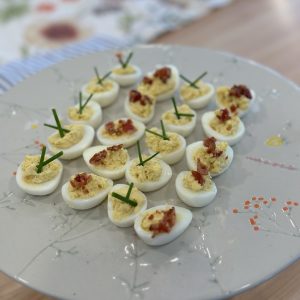Deviled Quail Eggs
For me, 16 quail eggs is 1 portion, but for you, this recipe might offer small bites for 4 to 6 people. It also makes a great addition to a plate as a clever garnish.
Ingredients
- 1 tablespoon salt, sea salt preferred, but any old salt will do. The salt is just for the boiling water.
- 8 quail eggs
- 2 teaspoons mayonnaise
- 1 teaspoon Dijon mustard
- Maldon sea salt flakes
- fresh black pepper
- paprika, ground
- chives, washed and dried and cut into 32 ¾-inch pieces
- thin-cut bacon strips, optional. Cooked and finely chopped into warm bacon bits
Instructions
Hey! Read all the instructions all the way through before you start doing anything!
- Boil some water in a small saucepot and add the “any old” salt. Note: Heavily salted water makes the eggs way easier to peel.
- Prepare a small ice bath from 75 percent ice and 25 percent cold water so you can immediately place the cooked eggs into the cooling bath. Note: If you don’t have ice, no problem. Just run cold water over the eggs after boiling until they are fully submerged and cooled—takes a minute or two. The point is to stop them from overcooking.
- With a spoon, add eggs gently to the boiling water. Make sure the water is at a low simmer once they are all in.
- Boil for 4 minutes, then remove the pot from the heat. Take out 1 egg with a slotted spoon and crack it open immediately to ensure it is hard-boiled before you remove the others. Note: The temperature the eggs started at can impact cooking time—super-cold eggs usually cook well at 4 minutes, but if they were at room temperature already, try 3 minutes.
- Once hard-boiled, plunge the eggs into your ice bath to stop the cooking. When cooled, peel the quail eggs by gently hitting one side against the sink basin to form a crack and then taking your fingers to gently squish it all over and loosen the shell.
- Using a straight-edged knife, cut the peeled eggs in half length-wise and scoop the yolks into a small bowl using a tiny spoon or whatever you have that works.
- To the yolks, add 1 teaspoon Dijon mustard, 2 teaspoons mayonnaise, Maldon salt, a couple turns of black pepper, and a sprinkle of paprika. Mix well with a fork - it should be creamy.
- Taste the mixture and adjust the seasoning to your preferences. Note: Keep in mind that the bacon, if you’re adding it, is salty.
- If you want to be all cheffy about it, you can add the yolk mixture to a piping bag with a star tip and pipe little rosettes back into the egg whites. Or you can just spoon the yolk back in, which looks gorgeous and rustic.
- Finish by sprinkling with paprika and another touch of Maldon. Place 2 chive sticks into the yolks in a slight crisscross shape and add the bacon here if you like.
Enjoy!
About the Author
 Renee Guilbault, Food Industry Leader and Activist, candidly shares how to join, how to navigate and how to step up and lead within a trillion dollar industry in her new book, A Taste of Opportunity, released in January. Renee has held leadership roles at Bon Appetit Management Company at Google, Pret A Manger, Compass Group and held a role on the Los Angeles Food Policy Council Leadership Board and its Coordinating Committee.
Renee Guilbault, Food Industry Leader and Activist, candidly shares how to join, how to navigate and how to step up and lead within a trillion dollar industry in her new book, A Taste of Opportunity, released in January. Renee has held leadership roles at Bon Appetit Management Company at Google, Pret A Manger, Compass Group and held a role on the Los Angeles Food Policy Council Leadership Board and its Coordinating Committee.